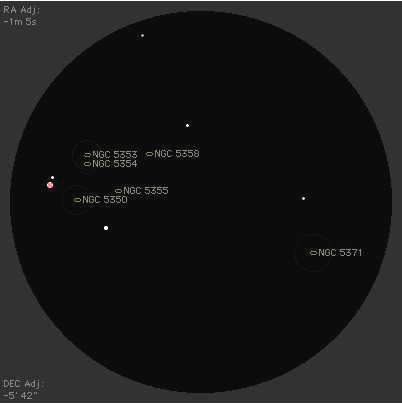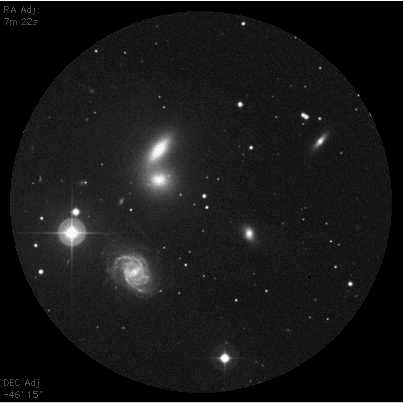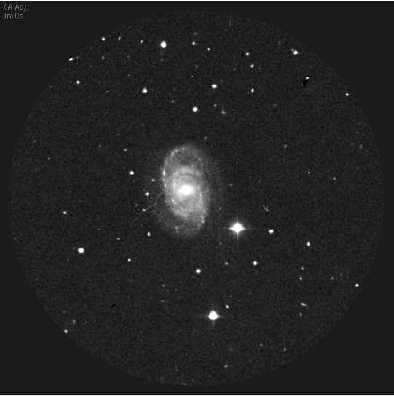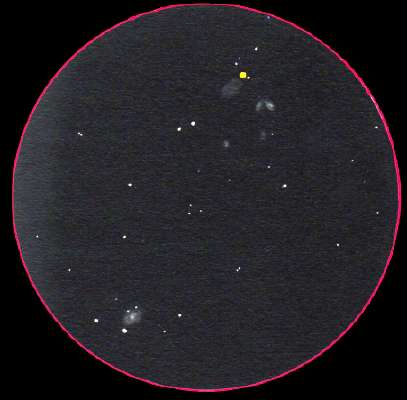Big Lick Galaxy Group

Big Lick Galaxy Group is found in Canes Venatici. This attractive group includes ten
galaxies, several of which can be seen with good transparency by average
amateur telescopes in the Northern Hemisphere.
This
group is nearly overhead during spring, which is ideal for most viewers in
Europe and North America. The DSS
image here is what could be seen with a large Dobsonian at 92x showing just
over 42 minutes field of view. A smaller scope won't be as bright, but could still locate most of these galaxies.
This
group is especially easy to find.
Just imagine that the Big Dipper's handle has one more star beyond its last one,
Alkaid. This extra star would
continue the handle's curve, and be just a bit farther removed from Alkaid than it is
from Mizar. That should get you
very close to this group. Of
course, you could always use go-to and/or coordinates, but a star-hopping search
is more fun.
Here is more
information about this group:
The
brightest galaxy is NGC 5371.
It is a fairly large spiral galaxy with low surface brightness, but not
too dim. It is set apart from the
others. NGC 5371 is magnitude
10.8, and is at RA 13h 55.7m, and Dec 40 degrees 28.02m. Size: 4.3 x 3.4.
NGC
5353
is second brightest. It is part of
the tight grouping. It is
magnitude 11.1, and is at RA 13h 53.5m, and Dec 40 degrees 16.98Õ. Size: 2.2 x 1.1.
Third
brightest is NGC 5350. It is part
of the tight grouping. It is
magnitude 11.4, and is at RA 13h 53.4m, and Dec 40 degrees 22.02m. Size: 3.1 x 2.3.
Fourth
is NGC 5354
at 11.5, and it is at RA 13h 53.5m, and Dec 40 degrees 18.00m. Size: 1.4 x 1.3.
There
are other galaxies visually associated with this group, such as NGC 5355 at 14 magnitude, and NGC
5358
also at 14 magnitude. Though dim,
they are small, so their light is more concentrated, allowing many of us to
visually see them.
The
bright star near 5350 is a beautiful K5 at 6.48 magnitude.
Below is the order of this grouping with a reflector:

Here is a DSS view of the left core at 252x:

Here is a DSS view of NGC 5371 at 252x:

Drawing by John Goss, Dob perspective, 24mm eyepiece:

How Did
"Big Lick" Stick?
The
name for this stellar group was originally suggested by John Goss, a member of
the Roanoke Valley Astronomical Society.
It was chosen to honor the early name for Roanoke, Virginia.

Roanoke
is home to the world's largest free standing star! It is eclipsed in size only by a string of lights on a hill
near El Paso, TX. Who ever heard of a
star on the side of a hill?
Roanoke's star soars into the night sky, and has done so since 1949 when
merchants erected it in honor of the Star City of the South. The only other standing star like this
is much smaller, in New Zealand.
Here
below is a view of Roanoke from the viewing platform atop Mill Mountain at the
base of the star. There is a spur
off the beautiful Blue Ridge Parkway leading to Mill Mountain:

What about Big Lick?
Big
Lick was named for a big salt lick marsh in the valley where prehistoric
megafauna gathered. These giant
beasts attracted hungry prehistoric spear hunters when they found the
valley. Soon thereafter, all that
was left to kill was small game, and fish in the Roanoke River.
Here's
a bit of history from the early days of Big Lick, courtesy of Wikipedia:
When the Virginia and
Tennessee Railroad (V&T) built through the Roanoke Valley in the
1850s, Big Lick was established as a stop. The name originated with a natural salt lick nearby.
After the American Civil War
(1861-1865), William Mahone,
a civil engineer and
hero of the Battle of the
Crater, was the driving force in the linkage of 3 Virginia
railroads, inclduing the V&T, to form the Atlantic,
Mississippi & Ohio Railroad (AM&O), a new line extending
from Norfolk to Bristol, Virginia in 1870. After several years of operating under
receiverships, Mahone's role as a railroad builder ended in 1881 when northern financial interests
took control. At the foreclosure
auction, the AM&O was purchased by E.W. Clark and Co., a private banking
firm in Philadelphia, which controlled the Shenandoah
Valley Railroad then under construction.
The AM&O was renamed Norfolk and
Western Railway (N&W).
Frederick J.
Kimball, a civil engineer and partner in the Clark firm, headed the
new line and consolidated it with the Shenandoah
Valley Railroad. For
the junction for the Shenandoah and the Norfolk and Western, Kimball and his
board of directors selected a small Virginia village called Big Lick, on the Roanoke River. Although the grateful citizens offered
to rename their town "Kimball", on his suggestion, they agreed to go
with Roanoke after the river. As
the N&W brought people and jobs, the Town of Roanoke quickly became an independent
city in 1884. In fact, Roanoke became a city so
quickly that it earned the nickname "Magic City."
###